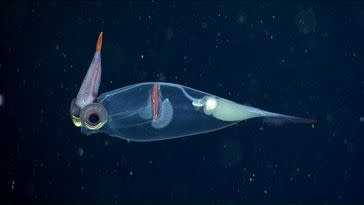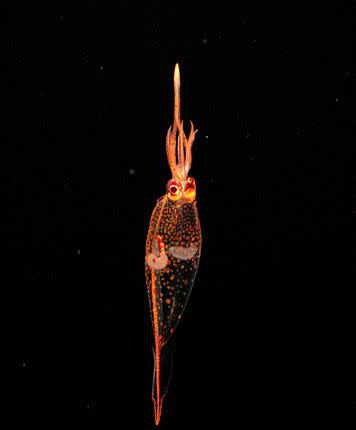Who is this see-through alien?

"Who is this alien?" is Mashable’s enduring series about the exceptionally peculiar critters that inhabit a relatively small, ocean-dominated world in the outer realms of the Milky Way galaxy, called Earth. Many of these lifeforms, you’ll find, are quite alien.
California's Monterey Bay teems with whales and vivacious seals. But, over 1,000 feet beneath the surface, swim the little-seen "glass squids."
They are transparent, except for their guts, arms, and bulbous eyes.
"They’re very alien looking," said Stephanie Bush, a marine ecologist who closely studied these creatures while working at the Monterey Bay Aquarium Research Institute (MBARI). "They have different body structures than what we’re used to."
Two particularly curious types of see-through squids residing in the crescent-shaped bay are the genuses Taonius and Galiteuthis — both from the same squid family.

Image: Monterey Bay Aquarium Research Institute (MBARI)
In the dingy, almost lightless (or even completely dark) ocean depths, the squids' translucence is crucial. "It's one of the common ways to hide yourself from predators in the deep, open ocean," noted Bush, who is now an invertebrate researcher at the Smithsonian Institution.
Deep sea predators are extremely sensitive to any light that penetrates through 1,000 or 2,000 feet of water. So, if something (like a squid) swims above a predator and alters the lighting or creates a silhouette — however faint — that something will likely soon be gulped up. "The idea is you have a very limited silhouette," said Bush. That's also why the glass squids often hold their pair of tentacles and eight arms up in the water, as if they're reaching for the sky — to limit their silhouette or shadow.
"They hold their arms and tentacles together in a bunch — like a cockatoo," said Bush.
It's not easy to catch a glimpse of these see-through creatures. MBARI spots them using underwater robots, known as remotely operated vehicles (ROVs), that dive down to the inhospitable ocean depths to observe the alien life therein.
SEE ALSO: Who is this alien? Why, it's the psychedelic frogfish.
While there's still much to grasp about these elusive deep sea lifeforms, Bush and other marine ecologists have observed a decent amount from these transparent squids. The Taonius, for example, is often found between some 1,300 and 2,620 feet beneath the surface (400 to 800 meters) in Monterey Bay, though they've been spotted in other oceans around the globe, too. They're about as long as the width of a sheet of paper (8.5 or so inches). It's unknown, however, what exactly they eat. But it's probably "whatever they can get their tentacles and arms on," said Bush.

Image: MONTEREY BAY AQUARIUM RESEARCH INSTITUTE (MBARI)
The Taonius' relative, the Galiteuthis, is especially unique in that the organism can inject ink into its transparent body, making it appear even darker — likely to better disguise itself from nearby predators. "They puff their body up and turn themselves into an opaque animal for a short amount of time," explained Bush.
In the deep, dark, eerie sea, both Taonius and Galiteuthis rely on big eyes to see through their blackened world. It's absolutely vital for finding a meal. And a mate.
"Their eyes are huge," said Bush. "They have to find a mate, too, or bye-bye to the species."
WATCH: Ever wonder how the universe might end?


